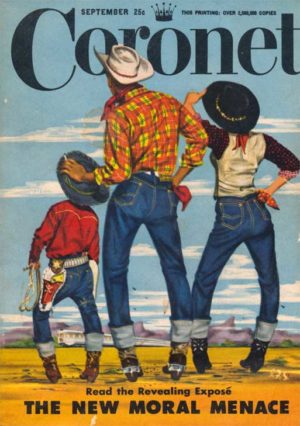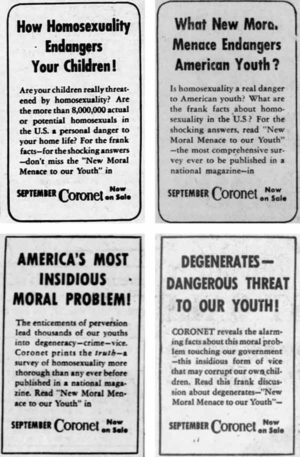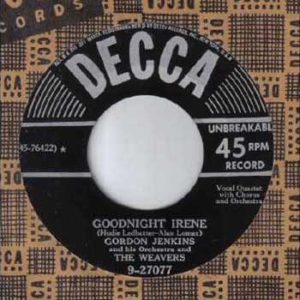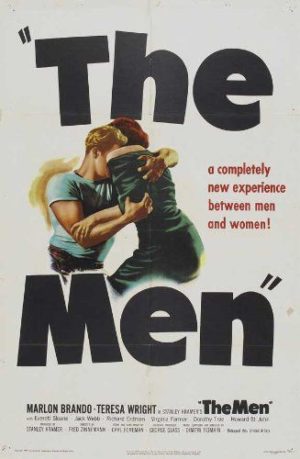
Coronet, was a general-interest digest magazine owned by Esquire. Similar to Readers Digest, it ran from 1936 to 1971. It shared its name with Coronet Films, which was a leading producer of education films shown in elementary, junior high, and high schools. While the films covered a wide range of school topics, the company is best remembered today for its social guidance films — dating, manners, good citizenship, how to be popular, and the like.
Coronet was very much a middle-to-conservative publication, aimed squarely at the typical middle-America of backyard barbecues and booming families. Which is why this article by Ralph H. Major, Jr., which appeared in the September 1950 issue of Coronet, makes for an excellent time capsule. It embodies all of the fears, prejudices, ignorance and disgust that the typical American had for homosexuals. Among the common beliefs Major echoed were:
- That homosexuals are male. The term “homosexual” is never defined anywhere in the article. Nevertheless, all of the pronouns are male, as are all of the names and descriptions. Lesbians aren’t mentioned at all, not even in passing.
- That there is “an alarming increase in the incidence of homosexuality.” Alfred Kinsey had only published his Sexual Behavior in the Human Male two years earlier. For most Americans, the “Kinsey Reports” were their first exposure to the very concept of homosexuality, let alone the numbers. This increased attention fueled the perception that homosexuality was something new and growing, rather than something that always existed but was never mentioned.
- That homosexuality can be “brought back under control.” Implicit in the belief that homosexuality is a growing phenomenon is the assumption that whatever went wrong can be made right. If homosexuality didn’t exist before, it can be made to not exist again.
- That homosexuals seduce “the young of both sexes.” Pedophilia was largely an unknown concept. It was just “perversion,” just like homosexuality was a “perversion.” If homosexuals were perverts, and perverts molested children, then homosexuals molested children, so the skewed logic went. That homosexuals would molest children of either gender just shows how far this fallacy can go.
- That homosexuals seduce “the youth.” Americans’ notion of “youth” was highly elastic in 1950. Anyone under the age of twenty-one might be considered “youth,” depending on the topic. (Major mentions “youngsters … of college age,” for example.) At the same time, men marrying girls of fifteen or sixteen wasn’t terribly uncommon. And if there was a whiff of scandal behind it, it was because people would just assume that he had gotten the girl pregnant. Gay men didn’t benefit from this attitudinal elasticity. Furthermore, gay men, by “seducing” the “youth,” create more homosexuals in the next generation, according to the assumptions at the time.
- The homosexuality typically leads to other criminal activity. Homosexuality is a crime in every state of the union in 1950. In many states, it’s a felony. And so the thinking went: “Why would they stop at breaking just one law?” By 1950, homosexuals were already being hounded out of the State Department because of their alleged propensity for giving away government secrets. Major follows the same flawed logic: homosexuals “descend through perversions to other forms of depravity, such as drug addiction, burglary, sadism and even murder. Once a man assumes the role of homosexual, he often throws off all moral restraints.”
- That homosexuals are hidden all around us. Actually, this one’s true. While “some homosexuals have rather obvious characteristics of the opposite sex” and others possess a “craving for self-expression carried to bizarre extremes,” at least they’re easy to spot. “Other sex aberrants look, act, and dress like anyone else,” warns Major. “It is they who are the real threat. “

Because homosexuals and “other sex aberrants” were much in the news over the past year, Coronet’s publisher capitalized on the headlines by placing ads for the September issue in major newspapers across the U.S. Ads like those you see here appeared in such papers as the Boston Globe and the Herald, Philadelphia Inquirer, Miami Herald, Detroit Free Press, Chicago Tribune, Minneapolis Star and the Morning Tribune, Los Angeles Times, Oakland Tribune, San Francisco Examiner, the Oregonian (Portland), and the Seattle Daily Times.
New Moral Menace to Our Youth
by Ralph H. Major, Jr.
In printing this article, CORONET seeks to demolish a long-standing taboo against a frank and factual discussion of homosexuality. Qualified editors and researchers spent six months collecting material, interviewing authorities, and evaluating information. The result is a significant survey of the entire subject as it endangers the youth of American — the most comprehensive such survey ever to be published in a national magazine.
— THE EDITORS
Behind a wall erected by apathy, ignorance, and a reluctance to face facts, a sinister threat to American youth is fast developing. Unlike disease and crime, this threat, until very recently, was seldom discussed in public; its existence was acknowledged only in whispers – and in sordid police and prison records. Not since the see-no-evil-hear-no-evil attitude toward syphilis has there been such an example of public refusal to grapple with a serious problem — in this case, the problem of homosexuality.
Although more than 8,000,000 Americans today are actual or potential homosexuals, it took a ballyhooed Congressional investigation to put homosexuality in the headlines, however inadequately. In words spoken more to alarm than to inform, Senator Joseph McCarthy last spring charged the State Department with employing a large number of homosexuals. In fact, subsequent findings disclosed that 91 such persons had been fired from the Department. But never was a sober attempt made to analyze the nature of these men who, because of sexual deviations, were labeled “bad security risks.”
Usually, homosexuals rate mention in the press only when they are involved in crimes. And yet, psychiatrists point out, they become the concern of the law only in extreme cases. Despite the awareness of doctors and social workers to this danger to American youth, prejudice and prudery have conspired to keep the truth from the public.
Unfortunately, in the case of this menace, it is difficult to arrive at the truth. For example, to assemble the facts in this article, CORONET interviewed sociologists, psychiatrists, clergymen, educators and prison officers — and homosexuals themselves. During this process one important and basic fact emerged; so little has been written about this subject that many people are unaware a danger exists, or even more significantly, that homosexuality is rapidly increasing throughout American today.
Amazingly, few surveys have ever been made of this growing segment of our population. Yet each successive report, however inadequate, shows an alarming increase in the incidence of homosexuality. The figures, scientists admit, are fantastically high; but for that very reason they demand public attention.
In the most recent and widespread survey, conducted by Dr. Alfred C. Kinsey and published in his celebrated work Sexual Behavior in the Human Male, it is reported that “37 per cent of the total male population has had at least some overt homosexual experience … between adolescence and old age.”
Moreover, Kinsey was astonished at his own figures. “We ourselves,” he wrote, “were totally unprepared to find such data when this research was undertaken.”
While a scientist like Dr. Kinsey was understandably surprised at the results of his survey, pitifully few laymen have echoed his sentiments. Most Americans assume either a scornful or a tolerant attitude toward these perverts. On one hand, the hip-swinging, falsetto-voiced man can excite such fury in other men as to provoke brutal attacks. Disgust and gutter humor thus characterize the reactions of the majority toward the “fairy.” On the other hand, many are inclined to regard the sex pervert merely as a “Queer” who never harms anyone but himself.
This is an extremely dangerous and shortsighted attitude, according to those who have studied the problem. For instance, Eugene D. Williams, Special Attorney General of the State of California declares: “All too often, we lose sight of the fact that the homosexual is an inveterate seducer of the young of both sexes, and that he presents a social problem because he is not content with being degenerate himself; he must have degenerate companions, and is ever seeking younger victims.”
Therein lurks the hidden danger of homosexuality. No degenerate can indulge his unnatural practices alone. He demands a partner. And the partner, more often than not, must come from the ranks of the young and innocent.
Each year, literally thousands of youngsters of high-school and college age are introduced to unnatural practices by inveterate seducers. Their stories, taken from psychiatrists’ notebooks, are lurid in detail and sordid in implications for the future. And they are sufficiently “close to home” to disturb every American parent.
After one year at an Eastern prep school, John T. came home last summer to spend his vacation. Two weeks later his father received a phone call from police headquarters.
“Your boy’s in trouble,” he was told. “Come down right away!”
John’s mother and father were shocked by what they discovered. Their son had been discovered in a warehouse with a delivery boy. Where had John picked up this abnormal habit? “One of the teachers at school taught me,” he admitted shamefacedly.
A short lad, John had not made friends easily at school. When he failed to win membership in an exclusive school club, he ran tearfully to a faculty member. This instructor, as it turned out, was more than solicitous. He persuaded John to forget his disappointment in a whirl of new thrills — thrills which made John feel far superior to his untutored classmates.
Fortunately, John’s parents were able to rescue him in time to prevent his complete conversion to the unfortunate cult.
Mark M. was not so lucky. Now in his late twenties, he lives in a tenement on the fringe of New York’s Harlem. Sharing his dingy flat is a lanky, unshaven derelict who peddles dope or books racing bets. When his provider is away from home, Mark hangs around neighborhood bars, killing with alcohol his memories of a happy youth. For Mark is the son of a prominent business leader whose name is familiar to millions. Eight years ago, Mark’s college record was excellent and wily society matrons were setting traps for this handsome bachelor.
But Mark decided to “take off a year” before settling down. He moved to Manhattan, where curiosity led him to seek out homosexuals such as he had heard about in fraternity “bull sessions.” One night, befuddled with liquor, he decided to experiment. His companion was the bookie. When they youth sobered up, he found himself ensnarled in a web from which escape was impossible. For the bookie, a long-time pervert, read society columns as well as racing forms. To him, Mark was not only a willing partner, but a potential meal ticket.
Faced with the facts, Mark grudgingly increased his demands on his father. After several months, when the checks stopped coming, the bookie told Mark:
“Either the old man coughs up or I tell him about us!”
In desperation, Mark begged his father for more money. Mr. M. asked a detective agency to find out about his son. He paled when he read the confidential report, and promptly cut off all ties, family as well as financial, with young Mark. Now the forsaken youth knows he is spiritually dead. But he continues to wander through Harlem, because he fears suicide if he stays alone in his apartment.
Mark is only one of many pathetic cases. And not all cases involve just an individual alone. Not long ago, police in a Southern state broke into an isolated beach cottage. What they found threw consternation into homes of a dozen families. For months, their teen-age sons had succumbed to the blandishments of a 40-year-old male pervert. After stuffing them with ice-cream sodas, he took them to his cottage. There he invited his bewildered guests into a “secret society” whose basic ritual involved perversion.
The youths had one sincere defense: ignorance. Their sinister host, however, was convicted on charges of contributing to the delinquency of minors.
After a disclosure of sex crimes alarmed St. Louis earlier this year, officials reported that 20 per cent of the victims were boys who been seduced by adult perverts. A juvenile court on the West Coast recently was faced with the problem of what to do with a 16-year-old homosexual. Instructed by an older comrade in the grosser points of perversion, the lad had gone on to organize a “clientele” of his own, composed of boys his own age.
“I’m a male prostitute,” he boasted. “These fellows pay me to play around with them.”
The shock and mental confusion suffered by youthful victims of such sordid experiences cannot be over-exaggerated. Psychiatric case histories bear eloquent testimony to the thousands of warped lives that follow in in the wake of associations with perverts.
A Philadelphia doctor, for example, furnished this dramatic excerpt from his files:
A young mother burst into his office one afternoon and cried, “I need help quickly!” The she sobbed out her story.
For several months, her 11-year-old son acted strangely. He seldom spoke at meals and shut himself in his room for hours at a time. As weeks went by, he lost his appetite — an odd phenomenon in a growing boy — and even shrugged off her good-night kisses. Finally, the youngster blurted out the whole chilling tale.
“A man used to hang around the playground and give us candy,” he told his mother. “One day he told me that if I’d take a ride in his car he’d but me a whole box of candy. I went along and then — and then it happened!”
The psychiatrist nodded knowingly, for the story is not a new one. The innocent boy had been enticed into perverted acts. For some deep-rooted reason he could not understand, the experience revolted him. But he had the candy, and the man promised him more. Thus, for weeks, the terrified lad had continued to spend nightmarish hours with his seducer.
It took the combined efforts of the boy’s sympathetic parents and the psychiatrist to rid the lad of what was fast developing into an incurable guilt complex.
Irreparable mental and psychological damage is only one side of the story. The other is even more reprehensible. Some male sex deviants do not stop with infecting the often-innocent partners: they descend through perversions to other forms of depravity, such as drug addiction, burglary, sadism and even murder.
Once a man assumes the role of homosexual, he often throws off all moral restraints. While thumbing his nose at society through his sexual perversions, at the same time he indulges in other vices that society brands as immoral.
Last year, a 19-year-old youth was arrested for holding up a restaurant. When police asked why he had committed the crime, the prisoner replied: “I wanted to prove to Maurice that I loved him enough to steal for him.”
Maurice, it developed, was his “boy friend,” a tough ex-convict who had teased the lad by telling him he lacked the guts to “do something daring.”
Such incidents of violence appear with alarming frequency in police records, Yet in CORONET’S survey, an astonishing fact was revealed: in few municipal police department or in FBI files are homosexual criminals identified. Even the FBI’s Uniform Crime Reports lumps offenses by them and all other perverts under the heading of “sex offenses.” Thus, it is impossible to estimate the number of crimes committed yearly by homosexuals in the U.S.!
Nor is the wave of criminal homosexuality likely to subside in the future, despite medical, legal, and social attacks on the problem. Last year, State Senator Thomas C. Desmond of New York conducted a survey on the subject among 25 top State police officials. He announced that “two out of three police chiefs report that known perverts are roaming the streets and that effective surveillance of these potential menaces is impossible.”
What can be done about this new menace to American youth? Plenty, say the experts. First, the public must be educated to recognize this form of perversion and its cohorts. “For far too long,” a recent psychiatric survey reported, “the sex deviation themes have remained screened behind the curtain of propriety — as venereal disease was a generation ago. For too long, the subject has been relegated to backstairs gossip and naughty literature.”
And Dr. William C. Menninger, one of the world’s top psychiatrists and director of Menninger Clinic, thus condemns public prejudice: “As one commonly hears the word (homosexual) used, it refers only to an adult who is variously described as ‘unbalanced,’ ‘criminal,’ and very often is regarded as just too low a form of scum of humanity to talk about.”
In some people, homosexuality may represent a passing phase in emotional development — a temporary protest against conservative morals or a craving for self-expression carried to bizarre extremes. In other cases, it eventually becomes a way of life, a fraternal comradeship which, to its zealots, is infinitely superior to normal human relations. To these members of a publicly scorned inner circle, homosexuality offers a refuge from the rigid pattern of normal society.
While the appearance of most of these unfortunates may betray them to watchful persons, other sex aberrants look, act, and dress like anyone else. It is they who are the real threat. For, until an overt action is committed, their victims sense no danger.
“Despite the fact that some homosexuals have rather obvious characteristics of the opposite sex,” says the Journal of the American Medical Association, “the majority of psychiatrists and sexologists believe that homosexuality is an acquired condition.”
Acquired? From whom? And how? These questions are asked by millions of Americans.
Actually, doctors do not know all the answers. Because society chooses to regard homosexuality as a moral abomination rather than as a medical problem, scientific research has progressed slowly. Even the AMA Journal has admitted frankly that “surprisingly little quantitative laboratory work has been reported in the study of homosexuality…”
From the best psychiatric evidence available however, these are the main reasons for developing homosexuality.
- Parental cultivation of infantilism in adolescents.
- Distortion of values produced by high-tension city life.
- Increasingly complicated economic conditions, causing reversion to homosexuality as an escape.
- Glandular disbalance.
Henry J.’s case history illustrates Reason No. 1. Only child of a middle-class family, Henry was educated at home until he was 17. Then he enrolled in a near-by university, commuting each day form his mother’s home.
Until his graduation at 21, the youth never dated a girl, participated in student activities, or attended a dance — because every night Mother demanded his presence at home. Even after graduation, she insisted that he live at home to save money.
Then Henry broadened his narrow horizon to include a position in a department store. Not long ago, a salesman invited Henry to dinner. Afterwards, he suggested Henry join him for a nightcap in his hotel room. When he found himself alone with the salesman, Henry felt strange yearnings. Suddenly he embraced his host.
Next day, Henry experienced two sensations: a feeling of guilt and an appetite for love. His desire to love and be loved, diverted by his mother from normal expression toward a woman, had found response in the young salesman. But Henry’s new-found joy in the unnatural relationship with another man soon burned itself out.
Today, although he has vainly tried to break out the alliance, he still sees his friend. And Henry has become a haggard neurotic. He knows there is no turning back. He knows, too, that there is no future in his homosexual activity. Yet he is doomed as surely as a fly caught in a spider web.
“There is a widespread among psychologists and psychiatrists,” writes Dr. Kinsey, “that the homosexual is a product of an effete and over-organized urban civilization. The failure to make (normal male-female adjustments is supposed to be consequent on the complexities of life in modern cities.”
Psychiatrists explain the city phenomenon this way: relationships in metropolitan areas tend to minimize family life in favor of business life. Office associates, fellow-workers, and friends of the same sex assume exaggerated emotional influence. Likewise, most large cities boast taverns, night clubs, and restaurants which cater almost exclusively to perverts and thereby become scenes of conversation for innocents seeking companionship. Moreover, Dr. Kinsey reports, this “city group” exhibits mannerisms which would appear out-of-place elsewhere but which, in urban centers, are ignored or tolerated.
Linked to urban life as a dominant cause of homosexuality is the fast-paced 20th-century economic struggle. This super-pressure frequently drives sensitive, introverted men and women to seek refuge in sexual aberrations. To many, perversion means security, an emotional relationship devoid of responsibilities.
Alan S., for instance, is a would-be composer who, while an undergraduate in college, developed a phobia against competitive business. Economic courses filled him with horror. So Alan finally buried himself in literature, where he found escape and nourishment.
Soon he began to notice that latent emotions were fired by what he read. He learned, too, that some of his classic literary heroes were avowed homosexuals. It wasn’t long before Alan discovered soul mates among his classmates. Soon he plunged with abandon into active homosexuality.
Alan has found his refuge but he has also found his personal hell. For now he realizes he cannot desert the human race; he cannot become a modern hermit. So he sits, lonely and miserable, in his boardinghouse and tries to compose music. Like others before him, he has learned that homosexuality is a jealous mistress; those whose affection it cannot keep, it kills.
Apart from mental and environmental reasons for homosexuality, another largely unexplored cause deserves study. Some men may suffer from a hormone deficiency that robs them of virility while, at the same time, endowing them with female characteristics. This disbalance in glandular functions sets them on the distaff side of the dividing line between sexes.
Unfortunately, little clinical research has been accomplished in this vital field of physiology. But in 1942, Drs. Abraham Myerson and Rudolph Neustadt reported that of a group of sex aberrants examined by them, endocrine disturbance was indicated in 83 per cent. In a group of non-homosexuals studied, the figure was only 2.5 per cent.
While medicine is making progress in solving the riddle of homosexuality, chief responsibility for preventive action rests with the public. Homosexuality may be a disease, a condition, a criminal offense of a mortal sin. Nevertheless, steps must be taken now to protect American youth from an ever-growing peril.
Every psychologist, sociologist and educator queried in CORONET’S survey stressed one point: “More than anyone else, parents are responsible for erasing the threat of homosexuality.” since parental attitudes and home environment are fundamental to healthy adolescent development, mothers and fathers should combat homosexuality and sympathetic understanding.
“I have met very few perverts who come from happy homes,” a famous doctor told CORONET.
Here are some suggestions from experts on how parents may protect their children against homosexuality and its converts:
- Sex education begins at home. Instruct boys and girls as early as possible in the knowledge of normal sex practices.
- Encourage your children to bring their sex problems and questions to you.
- Know your children’s friends; have them invited to your home where you can observe their conduct and personalities.
- Urge children to exercise caution in speaking to strangers; especially, instruct them never to accompany strangers anywhere without your permission.
- Investigate your children’s schools, camps, social clubs, and athletic organizations. Do not be afraid to ask frank questions of the adult leaders in charge. Bring to their attention any reports you may have heard of homosexuality within such a group.
In the history of modern society, there have been few menaces that frank and open discussion, coupled with intelligent action, have failed to eliminate. Once venereal disease was finally placed under the spotlight of public scrutiny, doctors found their task easier; today the dread evil is on the way to extinction. Likewise, national awareness to the problem of sex crimes resulted in t adoption of legal measures to stamp out this threat.
Now a new menace — homosexuality — has arisen. And again, the primary challenge is to mothers and fathers. Through knowledge of the facts, plus a concerted attack, the sinister shadow of sexual perversion can be removed from the pathway of America’s youth.
On the Timeline:
Previously:
![]() February 20, 1950: McCarthy links homosexuality and Communism.
February 20, 1950: McCarthy links homosexuality and Communism.
![]() February 28, 1950: The State Department reports dismissing 91 homosexuals.
February 28, 1950: The State Department reports dismissing 91 homosexuals.
![]() March 14, 1950: McCarthy names five “bad security risks,” including one homosexual.
March 14, 1950: McCarthy names five “bad security risks,” including one homosexual.
![]() March 31, 1950: Rep. Arthur L. Miller gives “the putrid facts” about homosexuality.
March 31, 1950: Rep. Arthur L. Miller gives “the putrid facts” about homosexuality.
![]() April 18, 1950: GOP Chairman says “perverts … have infiltrated our government.”
April 18, 1950: GOP Chairman says “perverts … have infiltrated our government.”
![]() May 3, 1950: Rep. Arthur L. Miller says the homosexual drive is similar to menstrual cycles.
May 3, 1950: Rep. Arthur L. Miller says the homosexual drive is similar to menstrual cycles.
This story:
![]() September 1950: Coronet magazine warns of a “new moral menace to our youth.”
September 1950: Coronet magazine warns of a “new moral menace to our youth.”
Periscope:
For September 1950:
| President: | Harry S Truman (D) | |||
| Vice-President: | Alben W. Barkley (D) | |||
| House: | 260 (D) | 167 (R) | 2 (Other) | 6 (Vacant) |
| Southern states: | 101 (D) | 2 (R) | 2 (Vacant) | |
| Senate: | 54 (D) | 42 (R) | ||
| Southern states: | 22 (D) | |||
| GDP growth: | 13.4% | (Annual) | ||
| 1.9% | (Quarterly) | |||
| Inflation: | 2.1% | |||
| Unemployment: | 4.4% | |||
| US killed in action, | 3,453 | (This month) | ||
| Korean conflict: | 8,182 | (Since Jun 28, 1950) | ||

Headlines: President Truman nationalizes the railroads to head of a nationwide strike. North Korean army lays siege to Taegu, South Korea’s temporary capital. Mao Tse Tung warns that China will intervene if North Korean territory is invaded. South Korean, U.S. and U.N. troops push North Korean army back north. Congress passes Internal Security Act (McCarran Act), which sets up Subversive Activities Control Board and gives the President broad powers to round up subversives into concentration camps. Actress Jean Muir is the first to fall victim to the Hollywood Blacklist when General Foods, sponsor and producer of the upcoming NBC sitcom The Aldrich Family, drops her from the program.
 In the record stores: “Goodnight, Irene” by Gordon Jenkins and the Weavers, “Mona Lisa” by Nat “King” Cole, “Simple Melody” by Bing Crosby, “Bonaparte’s Retreat” by Kay Starr, “Can Anyone Explain?” by the Ames Brothers, “No Other Love” by Jo Stafford, “Nola” by Less Paul, “Count Every Star” by the Hugo Winterhalter Orchestra, “Our Lady of Fatima” by Richard Hayes and Kitty Kallen,”I’ll Never Be Free” by Kay Starr and Tennessee Ernie Ford.
In the record stores: “Goodnight, Irene” by Gordon Jenkins and the Weavers, “Mona Lisa” by Nat “King” Cole, “Simple Melody” by Bing Crosby, “Bonaparte’s Retreat” by Kay Starr, “Can Anyone Explain?” by the Ames Brothers, “No Other Love” by Jo Stafford, “Nola” by Less Paul, “Count Every Star” by the Hugo Winterhalter Orchestra, “Our Lady of Fatima” by Richard Hayes and Kitty Kallen,”I’ll Never Be Free” by Kay Starr and Tennessee Ernie Ford.

On the radio: Lux Radio Theater (CBS), Jack Benny Program (CBS), Edgar Bergen & Charlie McCarthy (CBS), Amos & Andy (CBS), Arthur Godfrey’s Talent Scouts (CBS), My Friend Irma (CBS), Walter Winchell’s Journal (ABC), Red Skelton Show (CBS), You Bet Your Life w/Groucho Marx (NBC), Mr. Chameleon (CBS)
On television: Texaco Star Theater w/Milton Berle (NBC), Fireside Theatre (NBC), The Philco Television Playhouse (NBC), Your Show of Shows w/Sid Caesar and Imogene Coca (NBC), The Colgate Comedy Hour (NBC), Gillette Cavalcade of Sports (NBC), The Lone Ranger (ABC), Arthur Godfrey’s Talent Scouts (CBS), Hopalong Cassidy (NBC), Mama (CBS).
New York Times best sellers: Fiction: The Cardinal by Henry Morton Robinson, World Enough and Time by Robert Penn Warren, Jubilee Trail by Gwen Bristow. Non-fiction: Courtroom: The Story of Samuel S. Leibowitz by Quentin Reynolds, The Little Princesses: The Story of the Queen’s Childhood by Her Nanny by Marion Crawford, Look Younger, Live Longer by Gaylord Hauser.
Source:
Ralph H. Major, Jr. “New moral menace to our youth.” Coronet (September 1950): 101-108.
![[Emphasis Mine]](http://jimburroway.com/wp-content/uploads/2018/01/quiltmall.jpg)
